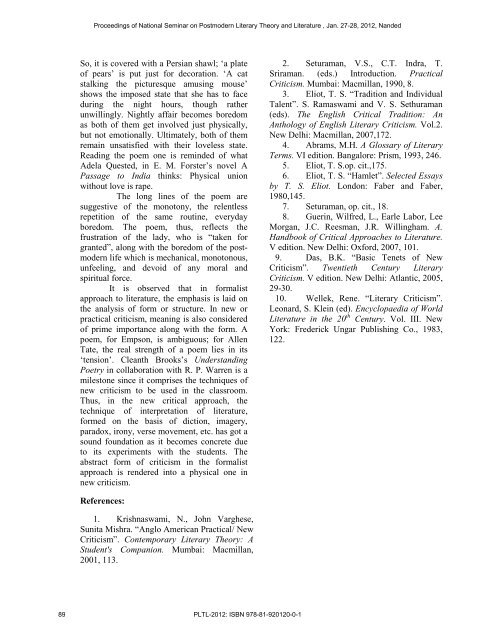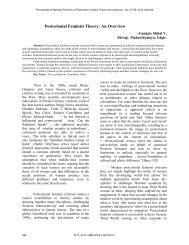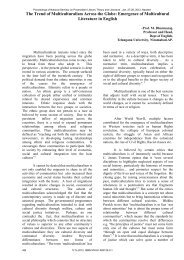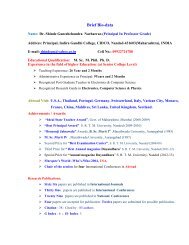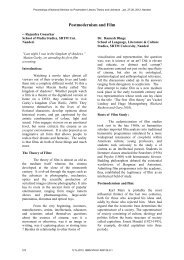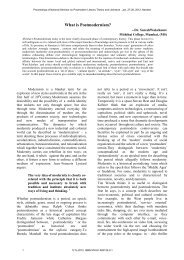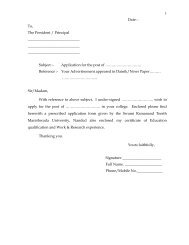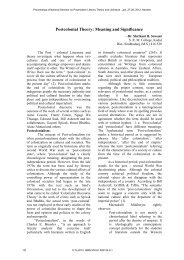Post-Structuralism: An Indian Preview - Igcollege.org
Post-Structuralism: An Indian Preview - Igcollege.org
Post-Structuralism: An Indian Preview - Igcollege.org
Create successful ePaper yourself
Turn your PDF publications into a flip-book with our unique Google optimized e-Paper software.
Proceedings of National Seminar on <strong>Post</strong>modern Literary Theory and Literature , Jan. 27-28, 2012, Nanded<br />
So, it is covered with a Persian shawl; ‘a plate<br />
of pears’ is put just for decoration. ‘A cat<br />
stalking the picturesque amusing mouse’<br />
shows the imposed state that she has to face<br />
during the night hours, though rather<br />
unwillingly. Nightly affair becomes boredom<br />
as both of them get involved just physically,<br />
but not emotionally. Ultimately, both of them<br />
remain unsatisfied with their loveless state.<br />
Reading the poem one is reminded of what<br />
Adela Quested, in E. M. Forster’s novel A<br />
Passage to India thinks: Physical union<br />
without love is rape.<br />
The long lines of the poem are<br />
suggestive of the monotony, the relentless<br />
repetition of the same routine, everyday<br />
boredom. The poem, thus, reflects the<br />
frustration of the lady, who is “taken for<br />
granted”, along with the boredom of the postmodern<br />
life which is mechanical, monotonous,<br />
unfeeling, and devoid of any moral and<br />
spiritual force.<br />
It is observed that in formalist<br />
approach to literature, the emphasis is laid on<br />
the analysis of form or structure. In new or<br />
practical criticism, meaning is also considered<br />
of prime importance along with the form. A<br />
poem, for Empson, is ambiguous; for Allen<br />
Tate, the real strength of a poem lies in its<br />
‘tension’. Cleanth Brooks’s Understanding<br />
Poetry in collaboration with R. P. Warren is a<br />
milestone since it comprises the techniques of<br />
new criticism to be used in the classroom.<br />
Thus, in the new critical approach, the<br />
technique of interpretation of literature,<br />
formed on the basis of diction, imagery,<br />
paradox, irony, verse movement, etc. has got a<br />
sound foundation as it becomes concrete due<br />
to its experiments with the students. The<br />
abstract form of criticism in the formalist<br />
approach is rendered into a physical one in<br />
new criticism.<br />
2. Seturaman, V.S., C.T. Indra, T.<br />
Sriraman. (eds.) Introduction. Practical<br />
Criticism. Mumbai: Macmillan, 1990, 8.<br />
3. Eliot, T. S. “Tradition and Individual<br />
Talent”. S. Ramaswami and V. S. Sethuraman<br />
(eds). The English Critical Tradition: <strong>An</strong><br />
<strong>An</strong>thology of English Literary Criticism. Vol.2.<br />
New Delhi: Macmillan, 2007,172.<br />
4. Abrams, M.H. A Glossary of Literary<br />
Terms. VI edition. Bangalore: Prism, 1993, 246.<br />
5. Eliot, T. S.op. cit.,175.<br />
6. Eliot, T. S. “Hamlet”. Selected Essays<br />
by T. S. Eliot. London: Faber and Faber,<br />
1980,145.<br />
7. Seturaman, op. cit., 18.<br />
8. Guerin, Wilfred, L., Earle Labor, Lee<br />
M<strong>org</strong>an, J.C. Reesman, J.R. Willingham. A.<br />
Handbook of Critical Approaches to Literature.<br />
V edition. New Delhi: Oxford, 2007, 101.<br />
9. Das, B.K. “Basic Tenets of New<br />
Criticism”. Twentieth Century Literary<br />
Criticism. V edition. New Delhi: Atlantic, 2005,<br />
29-30.<br />
10. Wellek, Rene. “Literary Criticism”.<br />
Leonard, S. Klein (ed). Encyclopaedia of World<br />
Literature in the 20 th Century. Vol. III. New<br />
York: Frederick Ungar Publishing Co., 1983,<br />
122.<br />
References:<br />
1. Krishnaswami, N., John Varghese,<br />
Sunita Mishra. “<strong>An</strong>glo American Practical/ New<br />
Criticism”. Contemporary Literary Theory: A<br />
Student's Companion. Mumbai: Macmillan,<br />
2001, 113.<br />
89 PLTL-2012: ISBN 978-81-920120-0-1


